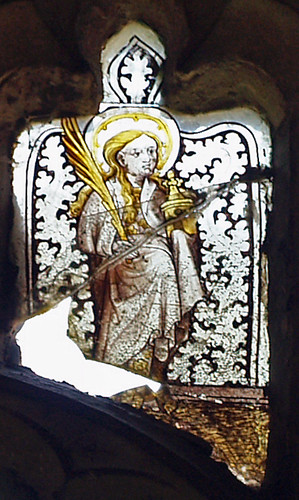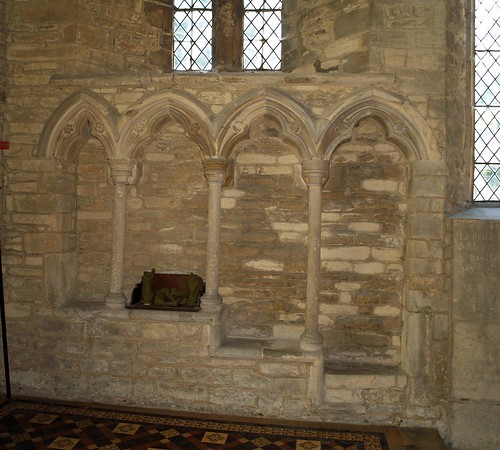ST JOHN BAPTIST. Of grey stone. The W tower is highly unusual and also poses a problem. Its W doorway with continuous mouldings is recessed behind a porch which is, however, flush with the wall. This porch has a high ogee arch beneath a gable with billet, cusped and subcusped and with buttress-shafts.Figure of a man above the ogee top; carved spandrels (a head, bust of a goat). Above it is a lozenge-shaped window with flowing tracery. All this is clearly Dec. The bell—openings are Perp - pairs of two lights with transom, and the blank arcading above is of course Perp too. But the broach spire (with high broaches) has three tiers of lucarnes in alternating directions, and they are as clearly C13 in style. The explanation is a rebuilding and remodelling of the spire in the favourite Victorian ‘Middle Pointed’, done in 1882. The tower buttresses are of the set-back type. The arch towards the nave has three chamfers and may well be Dec. Vaulting springers are preserved inside the tower. As for the rest of the church, the chancel is late C13, see the pointed-trefoiled priest’s doorway with stiff-leaf capitals and the chancel arch, the window with Y-tracery, and the good SEDILIA and PISCINA. Of the same time the arcades. They have piers alternatingly round and octagonal, and not only along but also across the nave. The S arcade is entirely a Victorian rebuilding or re-tooling. The N doorway with one order of (missing) colonnettes is E.E. too. Dec S porch entrance, Late Perp transepts, and Perp windows of specially nice design in the westernmost windows of the chancel and in the S transept and aisle. The N transept N window has an embattled transom. Good N transept and good nave roofs. - LECTERN and READING DESK. With Jacobean pieces. - BENCHES. A few are old, and one of them carries the date 1608. - STAINED GLASS. In one N and one S chancel window, including one small figure. - More in the N transept. - PLATE. Cup and Cover Paten of 1735-6; Plate of 1775-6. - MONUMENT. Leaning in the S aisle oaken cadaver from a C15 tomb (cf. Bishop Fleming at Lincoln).
KEYSTON. Its magnificent tower has been standing about 600 years, the elegant buttress rising to the very parapet. It has a glorious spire as old as itself, crowning a church with the loveliness our chief building centuries in its walls. Built into the porch and tower are a few stones with what is believed to be Saxon carving. In the walls of the south transept are three mass dials.
The nave, aisles, and chancel are 13th century, the clerestory 15th. The chancel has a charming doorway 700 years old, its capitals and spandrels rich with foliage. There are two fonts, a modern bowl on a 13th century shaft and a 13th century bowl without a shaft; we thought it a pity the two old things were not made one.
One grim and ugly sight of ancient days we found, a piece of English oak carved in the form of a skeleton, partly covered by a shroud; it seemed a curious thing to find in this fine place, this unpleasant conception of a craftsman 500 years ago. We loved much better the work of our own time in the east window here, beautiful glass in memory of Wilfred Horsley, who died for his country in France. There are lovely angels in the tracery with Our Lord in Majesty and Gabriel bringing the good news to Mary; and below, among a fine company of saints, evangelists, and prophets, is a Crucifixion scene, with St George of England on one side and Joan of France on the other. There is a little glass from the 15th century in other windows, in which we noticed oak leaves, crowns, stars, saints, and beautiful roundels; and there is a lovely figure in a white embroidered robe, a winged lion, and a saintly lady with a rich dress under her plain cloak. The roofs are the work of Elizabethan carpenters, who gave them charming roses and faces, and theirs also are the nail-studded doors with fine hinges, one with a ring handle which has been used by 12 generations of Keyston folk. The lectern and reading desk are Jacobean.
In a field are some very old coffin stones, as old as the king and queen and bishop who have been looking down from the outside chancel walls since the 13th century. On a farm is an ancient dovecot.
The nave, aisles, and chancel are 13th century, the clerestory 15th. The chancel has a charming doorway 700 years old, its capitals and spandrels rich with foliage. There are two fonts, a modern bowl on a 13th century shaft and a 13th century bowl without a shaft; we thought it a pity the two old things were not made one.
One grim and ugly sight of ancient days we found, a piece of English oak carved in the form of a skeleton, partly covered by a shroud; it seemed a curious thing to find in this fine place, this unpleasant conception of a craftsman 500 years ago. We loved much better the work of our own time in the east window here, beautiful glass in memory of Wilfred Horsley, who died for his country in France. There are lovely angels in the tracery with Our Lord in Majesty and Gabriel bringing the good news to Mary; and below, among a fine company of saints, evangelists, and prophets, is a Crucifixion scene, with St George of England on one side and Joan of France on the other. There is a little glass from the 15th century in other windows, in which we noticed oak leaves, crowns, stars, saints, and beautiful roundels; and there is a lovely figure in a white embroidered robe, a winged lion, and a saintly lady with a rich dress under her plain cloak. The roofs are the work of Elizabethan carpenters, who gave them charming roses and faces, and theirs also are the nail-studded doors with fine hinges, one with a ring handle which has been used by 12 generations of Keyston folk. The lectern and reading desk are Jacobean.
In a field are some very old coffin stones, as old as the king and queen and bishop who have been looking down from the outside chancel walls since the 13th century. On a farm is an ancient dovecot.



No comments:
Post a Comment